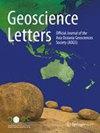The landslide source of the eastern Mediterranean tsunami on 6 February 2023 following the Mw 7.8 Kahramanmaraş (Türkiye) inland earthquake
IF 4.3
3区 地球科学
Q1 GEOSCIENCES, MULTIDISCIPLINARY
引用次数: 0
Abstract
Abstract This paper presents the first example of how to systematically identify the submarine landslide source of a tsunami using an innovative hybrid approach. This ground-breaking method is developed to resolve the puzzle around the source mechanism of the mysterious tsunami observed on 6th February 2023 in the Eastern Mediterranean Sea. The tsunami followed the two inland M w 7.8 and M w 7.5 Türkiye–Syria earthquakes, which occurred consequently with a 9 h interval on this day. The first earthquake (M w 7.8) had an epicentral distance of 90 km from the nearest coast, which is closer than the second one (M w 7.5) to the coast and yet its crustal deformation was almost entirely limited to inland. Therefore, the co-seismic surface displacement generated by the earthquake was ruled out as the source of the tsunami, confirmed by numerical modelling. Here, we hypothesized that the tsunami was most likely generated by a submarine landslide triggered by the earthquake. Analysis of tide gauge observations revealed that the waves arrived from 27 min to 48 min after the first earthquake (M w 7.8) at different coastal locations, implying that the potential submarine landslide was triggered by the first earthquake (M w 7.8). Backward tsunami travel time mapping using tide gauge observations guided us to constrain the area of the potential landslide. We approximated the dimensions of the landslide using spectral analysis of the tsunami observations. Consequently, an iterative trial-and-error approach was employed to confirm the landslide source of the tsunami by defining various informed alternative landslide scenarios and applying numerical modeling. Modelling showed that a submarine landslide can reproduce the tsunami observations reasonably well. It is located on a steep slope of the seafloor approximately 50 km from Arsuz. The submarine landslide is estimated to have caused a seafloor deformation measuring approximately 16 km in length and 4.0 km in width.2023年2月6日kahramanmaraku (t rkiye) 7.8级内陆地震后东地中海海啸的滑坡源
本文介绍了如何使用创新的混合方法系统地识别海啸的海底滑坡源的第一个例子。这种开创性的方法是为了解决围绕2023年2月6日在东地中海观测到的神秘海啸的来源机制的难题而开发的。此次海啸是继当天发生的两次内陆里氏7.8级和里氏7.5级叙利亚地震之后,每隔9小时发生一次。第一次地震(里氏7.8级)的震中距离最近的海岸90公里,比第二次地震(里氏7.5级)的震中距离海岸更近,但其地壳变形几乎完全局限于内陆。因此,排除了地震产生的同震地表位移是海啸的来源,并通过数值模拟证实了这一点。在这里,我们假设海啸很可能是由地震引发的海底滑坡引起的。验潮仪观测结果显示,在第一次地震(7.8级)发生后27 ~ 48分钟,波浪到达了不同的沿海地区,这意味着潜在的海底滑坡是由第一次地震(7.8级)引发的。利用潮汐计观测反演海啸传播时间,指导我们限制潜在滑坡的区域。我们利用海啸观测资料的光谱分析来估计滑坡的规模。因此,采用反复试错的方法,通过定义各种知情的替代滑坡情景和应用数值模拟来确定海啸的滑坡来源。模拟表明,海底滑坡可以相当好地再现海啸观测结果。它位于海底陡坡上,距离阿尔苏兹约50公里。据估计,海底滑坡造成了长约16公里、宽约4.0公里的海底变形。
本文章由计算机程序翻译,如有差异,请以英文原文为准。
求助全文
约1分钟内获得全文
求助全文
来源期刊

Geoscience Letters
Earth and Planetary Sciences-General Earth and Planetary Sciences
CiteScore
4.90
自引率
2.50%
发文量
42
审稿时长
25 weeks
期刊介绍:
Geoscience Letters is the official journal of the Asia Oceania Geosciences Society, and a fully open access journal published under the SpringerOpen brand. The journal publishes original, innovative and timely research letter articles and concise reviews on studies of the Earth and its environment, the planetary and space sciences. Contributions reflect the eight scientific sections of the AOGS: Atmospheric Sciences, Biogeosciences, Hydrological Sciences, Interdisciplinary Geosciences, Ocean Sciences, Planetary Sciences, Solar and Terrestrial Sciences, and Solid Earth Sciences. Geoscience Letters focuses on cutting-edge fundamental and applied research in the broad field of the geosciences, including the applications of geoscience research to societal problems. This journal is Open Access, providing rapid electronic publication of high-quality, peer-reviewed scientific contributions.
 求助内容:
求助内容: 应助结果提醒方式:
应助结果提醒方式:


